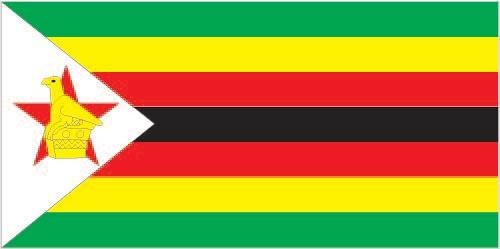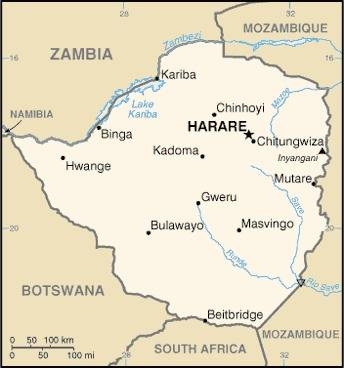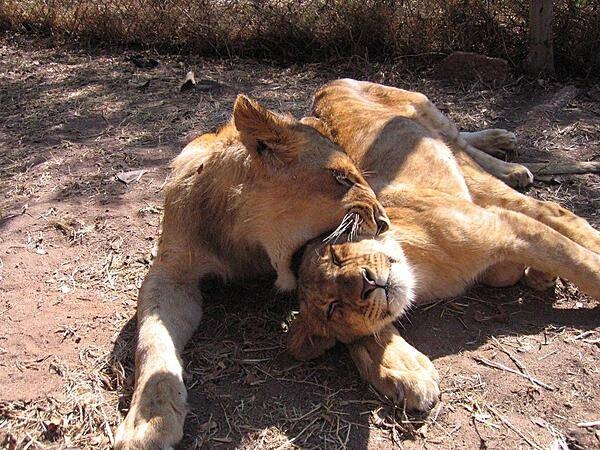230 Zimbabwe

Seven equal horizontal bands of green representing agriculture (top), yellow representing mineral wealth, red representing the blood shed to achieve independence, black representing the native people, red, yellow, and green with a white isosceles triangle edged in black with its base on the hoist side. A yellow Zimbabwe bird representing the long history of the country is superimposed on a red 5-pointed star in the center of the triangle, which symbolizes peace.
Flag courtesy of the CIA World Factbook

Map courtesy of the CIA World Factbook

Frolicking lions in a reserve in Harare.
Photo courtesy of the CIA World Factbook
Government
According to Britannica, Zimbabwe’s first constitution, which was written in London during September-December 1979 and which took effect at independence on April 18, 1980, secured majority rule for Zimbabweans. Under the constitution, white voters, registered on a separate roll, elected 20 of the 100 members of the House of Assembly. Although these members could not veto constitutional amendments, a unanimous vote was required during the first 10 years to alter the Declaration of Rights component of the constitution, which stipulated (among other matters) that, if land was acquired for settlement schemes, there must be “prompt payment of adequate compensation…remittable within a reasonable time to any country outside Zimbabwe.” The British insisted that there be a constitutional head of state, a president elected by the House of Assembly, and an executive prime minister and that citizenship of Zimbabwe be automatically available to anyone who was (or had the qualifications to be) a citizen of Rhodesia immediately before independence. In 1987 the office of prime minister was eliminated, with executive power instead being vested solely in the president, and additional constitutional amendments throughout the years served to strengthen the role of the president. Also in 1987 the practice of setting aside legislative seats elected from the white roll ended, and white voters were incorporated into the common roll.
The former Senate of 40 members was abolished with a constitutional amendment in 1990, and 50 members were added to the House of Assembly. The Senate was later reinstated in 2005. An amendment act passed in 2007 and effective with the 2008 elections increased the number of seats in both the House and the Senate and altered the allocation of seats. In 2009 the constitution was amended to provide for the creation of a coalition government via the terms of the 2008 Global Political Agreement (GPA), which attempted to end a political crisis in Zimbabwe. The structure of the executive branch was altered, allowing for the creation of a prime minister post and the creation of two deputy prime minister posts.
The GPA also provided for the drafting of a new constitution, which, after some delay, was completed in early 2013. The draft contained many changes from the previous constitution, including a stronger parliament, the introduction of presidential term limits, the elimination of presidential immunity from prosecution after leaving office, the abolition of the prime minister post, and a devolution of power. The new constitution was passed via referendum on March 16, 2013, and signed into law on May 22, 2013.
Under the 2013 constitution, Zimbabwe is a unitary republic. The head of state and government is the president, who is elected to a 5-year term; the president can serve no more than 2 terms. The president is assisted by 2 vice presidents. The parliament consists of the National Assembly and the Senate. The National Assembly normally has 210 members, all of whom are directly elected. For the first 2 parliaments elected after the promulgation of the 2013 constitution, however, the National Assembly has 270 seats, with the 60 additional seats reserved for women, 6 from each of the 8 provinces and the 2 cities with provincial status, elected through a system of proportional representation. The Senate comprises 80 members: 60 (6 from each of the 8 provinces and the 2 cities with provincial status) elected by a party-list system of proportional representation, with men and women being listed alternately on every list; 16 traditional chiefs elected by the provincial assemblies of chiefs in the 8 provinces; 2 seats for the president and deputy president of the National Council of Chiefs (the administrative body of traditional chiefs); and 2 representatives of people with disabilities. All parliament members serve five-year terms.
For administrative purposes, Zimbabwe is divided into 8 provinces and 2 cities with provincial status, Bulawayo and the capital, Harare, known as metropolitan provinces. The provinces and metropolitan provinces are further divided into districts. Provinces are administered by provincial councils; they are headed by a chairperson, who is elected by the council. Bulawayo and Harare are administered by metropolitan councils; the mayor of each city serves as a council chairperson.
Zimbabwe’s judicial system includes the Constitutional Court, which is the highest court in matters pertaining to the constitution; the Supreme Court, which is the highest court of appeal in all other matters; and the High Court, which has original jurisdiction in all civil and criminal matters and supervises the magistrates courts and other subordinate courts. There are also a Labour Court and an Administrative Court, as well as customary law courts, which adjudicate on matters of traditional law and custom.
Civil Aviation Authority of Zimbabwe (CAAZ)
The Civil Aviation Authority of Zimbabwe (CAAZ) is mandated to support safe, regular and efficient use and development of aviation services around Zimbabwe, as well as advise the government about domestic and international aviation applications.
Airspace
SkyVector – Google Maps – ADS-B Exchange
ICAO countries publish an Aeronautical Information Publication (AIP). This document is divided into three parts: General (GEN), En Route (ENR) and Aerodromes (AD). ENR 1.4 details the types of airspace classes they chose to adopt from classes A through G.
Drone Regulations
Civil Aviation Act of Zimbabwe
CA Form 520 RPA Drone Registration Application for Individuals
2022 – Zimbabwe: CAAZ Clarifies Regulations On Use of Drones
2018 – Civil Aviation (Remotely Piloted Aircraft) Regulations
Advanced Air Mobility (AAM) Regulations & Policies
None found by the author.
However, should you, the reader, happen to stumble across something to the contrary, please email the author at FISHE5CA@erau.edu and you may be mentioned in the ACKNOWLEDGEMENTS section of this book by way of thanks for contributing to this free eBook!
Advanced Air Mobility (AAM) News
None found by the author.
However, should you, the reader, happen to stumble across something to the contrary, please email the author at FISHE5CA@erau.edu and you may be mentioned in the ACKNOWLEDGEMENTS section of this book by way of thanks for contributing to this free eBook!
Short Essay Questions
Scenario-Based Question
You have been hired by a Drone Startup Company. Your boss has immediately assigned this job to you.
They need you to prepare a one-page memo detailing the legalities of using a drone to film lions in Harare, pictured above.
They need you to mention any national laws and local ordinances.
They specifically want to know what airspace (insert pictures) you will be operating in and whether or not you need an airspace authorization.
Does it matter whether or not you are a citizen of the country?
Lastly, there is a bonus for you if, as you scroll through this chapter, you find any typos or broken links!
Short Essay Questions
- What are the drone categories?
- How is registration addressed?
- How is remote ID addressed?
- What are the model aircraft rules?
- What are the commercial drone rules?
- Are there waivers or exemptions to the rules? If so, for what?
- Would you share a link to an interactive airspace map?
- How is BVLOS addressed?
- How can you fly drones at night?
- How can you fly drones over people?
- Where do you find drone NOTAMs?
- What are the rules for drone maintenance?
- What are the rules for an SMS program?
- What are some unique rules not mentioned above?
- What are the C-UAS rules?
- What are the AAM rules?

